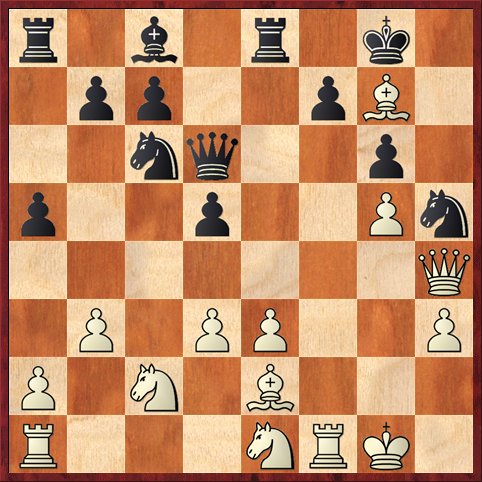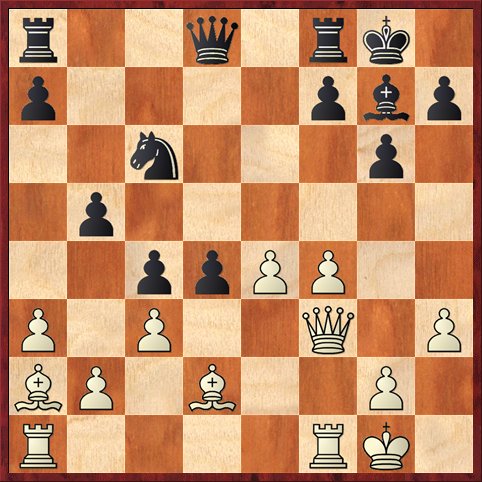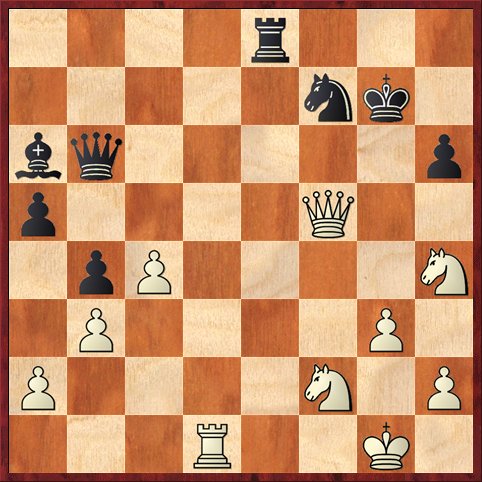Usually when I write about games I have recently played, I show you most or all of the game and have several diagrams along the way. This time I’m going to do something different. I played six games in my tournament from last weekend, and I’m going to show you one position from each game. I have not yet done thorough, definitive analyses of any of them, so I would welcome input. As long as the Comments button continues to not work, please feel free to send comments to me at qxpch (at) yahoo (dot) com.
 FEN: r1b1r1k1/1pp2pB1/2nq2p1/p2p2Pn/7Q/1P1PP2P/P1N1B3/R3NRK1 b – – 0 19
FEN: r1b1r1k1/1pp2pB1/2nq2p1/p2p2Pn/7Q/1P1PP2P/P1N1B3/R3NRK1 b – – 0 19
Position after 19. Bxg7. Black to play.
In my first-round game against Praveen Narayanan, I had White and played Bird’s Opening (1. f4). Michael (fpawn) Aigner would be pleased! In this position I have just taken on g7 and Praveen has to decide which way to take back. I thought that the answer was obvious, but Praveen surprised me by taking the other way.
19. … Kxg7??
There’s a good lesson here that I often forget — your opponent may have completely different ideas about the position than you do. I thought that 19. … Nxg7 was automatic, with the knight heading for a nice outpost on f5. It’s true that there is a problem with this move: it allows 20. Rf6. The rook is annoying on f6, it can’t be driven away easily, and it sets up long-term threats of advancing a pawn to h5 and then putting the g6 pawn under severe pressure.
That being said, White’s position is by no means automatically better after 20. Rf6. There’s always the potential that it could get trapped by … Nf5. Although I would rather be White in this position, it’s still a game.
However, Praveen’s 19. … Kg7 just loses material. It was based on a misconception: after 20. Bxh5 he played 20. … Rh8, which he thought would pin the bishop and win it, giving him great attacking chances on the h-file. But he missed two consecutive zwischenzugs: 21. Qf2! (threatening mate on f7) Ne5 22. Qf6+! Qxf6 23. gf+. Actually I guess that’s three zwischenzugs, the key point being that I recaptured on f6 with check. He moved his king away (23. … Kh6) and that gave me time to rescue the bishop (24. Bg4) and I remained a piece up. The rest was just mop-up.
This was more a game that Praveen lost than a game I won, but that’s kind of what you hope for when you’re paired against a lower-rated opponent in round one. The tournament was off to a good start for me.
 FEN: r2q1rk1/p4pbp/2n3p1/1p6/2ppPP2/P1P2Q1P/BP1B2P1/R4RK1 b – – 0 18
FEN: r2q1rk1/p4pbp/2n3p1/1p6/2ppPP2/P1P2Q1P/BP1B2P1/R4RK1 b – – 0 18
Position after 18. c3. Black to move.
Another round, another Bird! This time my opponent was Christopher Pan, I was Black, and the opening was my favorite Bird Variation of the Ruy Lopez. He has just played 18. c3, a move I didn’t quite understand, and now I have an interesting decision: to push on to d3 or to take on c3?
I am by no means sure that I made the best decision, but it definitely set the tone for the rest of the game. If this were a blitz game, I would probably play 18. … d3 without hesitation. Who can resist the idea of locking up the light-squared bishop forever?
However, with a longer time to think about it, I changed my mind. There were several reasons. First, if I push to d3 I have committed myself to a very static pawn structure. The queenside pawns could become targets, and if White should ever eliminate the c-pawn, the pawn at d3 will be dead, too. So capturing on c3 is a lower-risk move.
There are other points in favor of 18. … dc. A key one is that it opens up the d-file for my rooks. It also opens the long diagonal. If White should recapture on c3 with a pawn (not right away of course, but perhaps after a trade of bishops) he will have big weaknesses to defend.
Now, to some extent White can oppose all of these ideas. He can get his bishop on c3 to oppose my dark-squared bishop. He can move his rooks to d1 to oppose my rooks. What is likely to ensue is a bunch of trades. But the most important, and subtlest, point is that these trades are not neutral. They are distinctly in my favor, because they leave me with a powerful queen and knight against White’s queen and very ineffective bishop.
I have to say that I was pretty proud of this concept, and I think that the idea of taking stock of the possible trades in the position is something that has rubbed off on me from Mike Splane’s parties.
Indeed, that’s exactly what occurred. After 18. … dc 19. Bxc3 Qb6+ 20. Kh1 Rad8 21. Rad1 Rxd1 22. Rxd1 Bxc3 23. Qxc3 Rd8 24. Rxd8+ Qxd8 25. Qc2 Qd4! I stood much better and went on to win easily. I really liked this game and may do a ChessLecture on it, perhaps in combination with my round six game in which I also exchanged to victory.
Round three, however, is when things started to go sour. I was playing White against Ladia Jirasek.
 FEN: 4r3/5nk1/bq5p/p4Q2/1pP4N/1P4P1/P4N1P/3R2K1 w – – 0 35
FEN: 4r3/5nk1/bq5p/p4Q2/1pP4N/1P4P1/P4N1P/3R2K1 w – – 0 35
Position after 34. … Kg7. White to move.
Here I played what I think was my worst blunder of the tournament. Looking at the position now, I can’t believe I didn’t play 35. Rd7, which does allow Black a couple of spite checks but more importantly forces him to trade queens or get mated. Once the queens are off the board, I feel confident that my two-pawn advantage would be enough to win.
Instead, I played the exceedingly hasty and impulsive move 35. c5??, which makes absolutely no sense. First, it opens up an important diagonal for Black’s bishop. Second, it chases Black’s queen to a square she wants to go to (c6). Third, Black will get very serious mating threats with moves like … Bb7 and … Ng5. (In fact, even if I manage to get queens off the board, those threats will persist.) Notice, also, that after 35. c5 Qc6 I now cannot play my best attacking move 36. Rd7 because now 36. … Re1+ is mate. What a difference! Finally, on c5 the pawn is no longer strong but is critically weak and will probably fall. All of these terrible consequences just for the sake of one little tempo.
Why did I play such a bad move? Well, I was low on time, with about four minutes left for six moves. And I was just not doing what a chess player should do in every position, which is to stop and look at the options. Four minutes for six moves is scary, but it’s still enough time to take a breath. The important thing is not to get in the mentality of playing the first move you see, which is exactly the way I was thinking.
After 35. c5?? Qc6 I continued 36. Qg4+, and Jirasek played 36. … Kh7 and offered a draw. He was surprised when I accepted! But I think it was absolutely the right decision. If I attempt to win, I get into huge trouble in every variation. For example, if 37. Nf5 Ng5 38. Nd4 Qxc5 39. Qf5+ Qxf5 40. Nxf5 it looks as if I have gotten to an endgame, albeit at the cost of one of my two pawns. But I’m still a pawn up, right? I’m still winning? Wrong! After 40. … Nf3+ 41. Kg2 Ne1+ Black has at least a draw, and he might even be able to play for more.
In fact, the only decent line I see for White is 37. Qf5+ Kg7 38. Qg4+, with a draw by repetition. So a draw is a “natural” result here, even if Jirasek hadn’t made the offer.
Even aside from the chess factors, there were emotional factors. My time was now down to three minutes. I was by this point starting to grasp that 35. c5?? had been a colossal blunder. I had no faith left in my position; the rook and both knights are (or will soon be) completely tied down defending mate threats, and I didn’t see any plan that would get me out of the mess. For all these reasons, I accepted Jirasek’s offer with almost a sense of relief. Even if it meant catching some grief from other players later. “You agreed to a draw when you were two pawns up??? What???”
That’s enough for this post. Next time, three more games and three more crucial positions.


